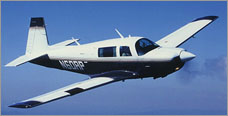 Harare, Zimbabwe - Hwange National Park, Zimbabwe
Harare, Zimbabwe - Hwange National Park, Zimbabwe
On October 10th I took off from Harare in hot, arid conditions for an adventure within an adventure. I flew the short two hour hop to the very impressive airport at Hwange National Park, also in Zimbabwe. Hwange is home to huge populations of natural African wildlife within its expansive borders. I landed on Hwange's three mile long runway and taxied to a tie-down spot near the control tower.
I was soon greeted by another, very different kind of pilot. Matt was a true bush pilot, who plies the skies of wild Africa. He helped transfer my bags into his Cessna 206, and off we went to a short gravel strip about 15 minutes flying time to the west. (I could NEVER have gotten into and back out of that strip in the Mooney, which is anything but a short field airplane.) There I was met by a guide from the Giraffe Springs safari camp in his LandRover, and within a few minutes I was in the camp.
The 48 hours at Giraffe Springs and its surrounding area became perhaps the most memorable two days of my life. The pictures below will give you a good idea of the experience. It's a bit exhilarating to eat breakfast under an open sided tent right beside an actively populated elephant watering hole, have lunch under the watchful eyes of three grazing zebras, and track three lions, two of whom had actually wandered up to and rubbed the side of your sleeping tent the night before! What a rush!
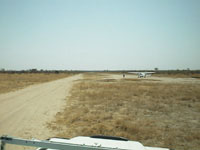 Leaving Harare, I flew to the 15,000 ft long runway at Hwange National Park's airport in northwestern Zimbabwe. My goal was to get to this tiny gravel airstrip in the African bush for a short safari, but the Mooney could not have gotten back out of such a short, high elevation, aerodrome. Thus, I reluctantly flew into the Park's main airport, where I jumped into an STOL (short takeoff and landing equipped) plane and rode with a bush pilot to the safari strip. The process was reversed coming back 48 hours later. Here is a picture of that desolate strip and the bush plane. Pilot Chris Souchon is walking up and down the runway inspecting for potholes and large, propeller damaging stones. If you look closely enough you'll notice a large bull elephant at the rear left. He had just walked across the runway moments before, never stopping to obtain air traffic clearance!
Leaving Harare, I flew to the 15,000 ft long runway at Hwange National Park's airport in northwestern Zimbabwe. My goal was to get to this tiny gravel airstrip in the African bush for a short safari, but the Mooney could not have gotten back out of such a short, high elevation, aerodrome. Thus, I reluctantly flew into the Park's main airport, where I jumped into an STOL (short takeoff and landing equipped) plane and rode with a bush pilot to the safari strip. The process was reversed coming back 48 hours later. Here is a picture of that desolate strip and the bush plane. Pilot Chris Souchon is walking up and down the runway inspecting for potholes and large, propeller damaging stones. If you look closely enough you'll notice a large bull elephant at the rear left. He had just walked across the runway moments before, never stopping to obtain air traffic clearance!
| Going on safari isn't quite the tough life it was earlier in this century. Here's a view of the interior of the main lodge building at my safari camp, which was called Giraffe Springs. There were no walls, and I could see elephants, giraffes, hyenas, impala's, wild dogs, and all manner of birds drinking at a waterhole no more than 200 ft away as the other guests and I ate our meals in this structure. |
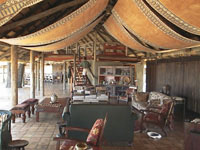 |
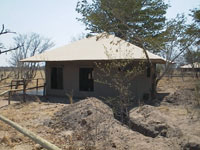 An exterior view of my private tent at Giraffe Springs. It was, indeed, a tent, with canvas walls and roof, all supported by a strong superstructure of wood poles. Through the thin walls trumpeting elephants and, during the first night, a roaring lion could easily be heard. Elephants could come right up to the tent, and they often did during the night to grab trunkfuls of the tall grass nearby. A deep trench had therefore been dug around the rear of each guest tent, protecting the solar heated water tanks out back from destruction by thirsty pachyderms who are very clever at finding precious water during this dry season. On the second night I slept well despite the sound effects of the creatures outside, feeling that by then I was an "expert" and shouldn't be worried. However, when one of the guides came around the next morning at 5:30am to awaken me for our morning trek through the bush, we found two sets of adult female lion tracks all around my tent. Whew!
An exterior view of my private tent at Giraffe Springs. It was, indeed, a tent, with canvas walls and roof, all supported by a strong superstructure of wood poles. Through the thin walls trumpeting elephants and, during the first night, a roaring lion could easily be heard. Elephants could come right up to the tent, and they often did during the night to grab trunkfuls of the tall grass nearby. A deep trench had therefore been dug around the rear of each guest tent, protecting the solar heated water tanks out back from destruction by thirsty pachyderms who are very clever at finding precious water during this dry season. On the second night I slept well despite the sound effects of the creatures outside, feeling that by then I was an "expert" and shouldn't be worried. However, when one of the guides came around the next morning at 5:30am to awaken me for our morning trek through the bush, we found two sets of adult female lion tracks all around my tent. Whew!
| What a real lion track looks like! |
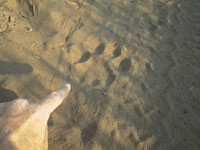 |
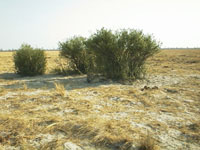 What a real lion looks like in the wild. This is no zoo! Guide Nigel Robie and his "copilot" fiancee Gina tracked down this resting adult male just after the cat had finished off a freshly caught warthog. They observed it about 20 ft away (lying in the shade to the left of the nearest bush) from the relative safety of their LandRover. Most wild animals in Africa have become accustomed to the vehicles and ignore them, provided that the riders remain still and don't make any sounds above a whisper. Getting off and taking a walk is a different matter altogether, and the rifle toting guides made sure their neophyte passengers understood this. I took this picture from the vehicle, feeling no pressing need to dismount and try to get any closer!
What a real lion looks like in the wild. This is no zoo! Guide Nigel Robie and his "copilot" fiancee Gina tracked down this resting adult male just after the cat had finished off a freshly caught warthog. They observed it about 20 ft away (lying in the shade to the left of the nearest bush) from the relative safety of their LandRover. Most wild animals in Africa have become accustomed to the vehicles and ignore them, provided that the riders remain still and don't make any sounds above a whisper. Getting off and taking a walk is a different matter altogether, and the rifle toting guides made sure their neophyte passengers understood this. I took this picture from the vehicle, feeling no pressing need to dismount and try to get any closer!
| Once safely out of range of the amply toothed feline, Nigel took me for a walk around an area frequented by a number of elephants. Here Nigel shows off a broken tusk he found lying on the ground, probably the remnant of a battle between two males over the affections of a collection of females. If broken high enough, severed tusks can be extremely painful for elephants, often inciting them into violent behavior. The few times elephants have charged humans, an aggravating factor such as this often contributed to the incident. |
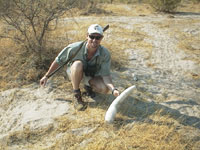 |
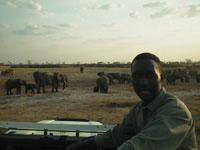 |
Sunset over an elephant watering hole. Note the lack of obvious standing water. Local guide Saide Piri is explaining that over the eons these elephants have learned to literally "dig" for water during the lengthy dry season. Through trial and error, this herd has determined that the water table under this dried up water hole is very high, so they have excavated a number of drinking holes, each a few feet deep, using their very versatile trunks. They then take turns sucking up quarts of the refreshing artesian water into their trunks and then squirt the stuff into their mouths. Each elephant consumes many gallons of water each day in this hot and dry climate. |
| Getting ready to leave Giraffe Springs' back country airstrip for the short hop to Hwange Airport, I'm posing here with safari campmates Shaifalika and Subhrakant Panda. These new friends also brought a digital camera with them to the camp, but unlike me, they had the foresight to bring one with a zoom telephoto lens. Subhrakant thus got a number of excellent close-up pictures of the wildlife, including the lion pictured earlier. |
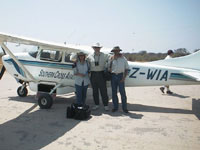 |
Next Stop: Victoria Falls, Zimbabwe
![[image map, use itinerary]](/grphx/n_globe.gif)
